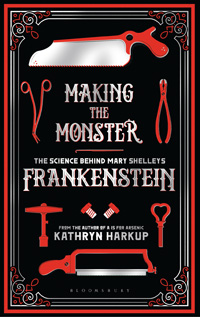
Your complimentary articles
You’ve read one of your four complimentary articles for this month.
You can read four articles free per month. To have complete access to the thousands of philosophy articles on this site, please
Interview
Kathryn Harkup
Tim Madigan meets the author of Making the Monster: The Science Behind Mary Shelley’s Frankenstein.
Kathryn Harkup is a chemist and author. After completing her doctorate on her favourite chemicals, phosphines, she went on to further research before realising that talking, writing and demonstrating science was more appealing than hours of slaving over a hot fume-hood. In her new book, she takes a look at the science of meddling in God’s domain.
You begin your book with a quote from Frankenstein, Chapter III: “But these philosophers, whose hands seem only made to dabble in dirt, and their eyes to pore over the microscope or crucible, have indeed performed miracles.” Who were the ‘philosophers’ Victor Frankenstein had in mind here?

Mary Shelley is referring to people such as Humphry Davy, Benjamin Franklin, Joseph Priestley and Antoine Lavoisier, all of whom had made enormous contributions to the advancement of science, particularly chemistry and electricity. The quote is taken from the moment Victor first hears Professor Waldman lecture at Ingolstadt University. Mary paraphrased much of Humphry Davy’s Introduction to his Elements of Chemical Philosophy to describe the recent advances in scientific understanding.
Mary Shelley was the daughter of two famous (or infamous) philosophers, the feminist Mary Wollstonecraft and the anarchist William Godwin. What influence did her parents have on her thinking?
Both parents had a huge influence on Mary. The political philosophy that both William Godwin and Mary Wollstonecraft wrote about and believed in, Mary lived. For example, she ignored the conventions of marriage when she ran away with the already-married Percy Shelley. Her novels explore many of Godwin’s themes of natural justice. Frankenstein in particular explores the responsibilities and duties of care we have to our fellow creatures. Much of the early criticism of Frankenstein was because of its obvious Godwinian influences and sympathies.
It’s remarkable that Shelley was only eighteen when she conceived and wrote Frankenstein. How did her own education and her interests in the scientific knowledge of her day contribute to this?
Mary had very broad intellectual interests. Her childhood saw a steady stream of philosophers, scientists, politicians, writers and artists pass through her home for intellectual discussions. Her father had a vast library and ran a publishing company and book shop. Her upbringing instilled a love of reading and learning. Mary read extensively, for long periods every day and on a wide variety of topics. She studied languages and attended lectures.
Scientific topics were very popular at the time, and discussed widely, not just in books and academic journals, but in public lectures, coffee houses, and homes. We certainly know such conversation happened in the Shelley household. The challenge for each of them to write a ghost story [one of the results being Frankenstein] was set by Lord Byron, when Byron, the Shelley party, and doctor John Polidori were gathered together late one night on the shores of Lake Geneva as storms raged outside. And although they read ghost stories to each other, the evenings preceding the challenge had been filled with conversations about science and the nature of life.
Would you consider Frankenstein to be an exemplar of the Enlightenment?
Yes, I think it is. Frankenstein, through the character of Victor, captures beautifully the rapid rate of scientific discovery, and the excitement relating to what these discoveries might lead to, but also the frightening possibilities. The novel also extends the Enlightenment’s mechanistic view of the universe to living things: if all the parts of a biological machine can be gathered and assembled correctly, then they should function as a living, breathing creature. The Enlightenment was also about sharing knowledge as widely as possible, and Frankenstein takes the dangers of not sharing ideas with a wider audience to its extreme.
Do you think Victor Frankenstein is a ‘mad scientist’?
No. Absolutely not. He is obsessed, maybe, lacking in foresight, and desperately in need of an ethics committee to oversee his work, but he is not mad. The image of the mad scientist is entirely from film and theatrical adaptations of the novel.
You close your book by writing: “Some 200 years after its first publication the reality of Frankenstein’s science is still the stuff of fiction. But perhaps it is getting a little closer to science fact.” Can you elaborate?
Scientific advances, particularly in medicine, continue to push at the boundaries of possible human existence. Advances in organ transplants have made us think about what truly makes us who we are. AI prompts us to explore the possibilities of forms of life different from those we’re used to. Science continues to present ethical challenges to us. I hope we respond better than some of the characters in Frankenstein.
• Kathryn Harkup gives regular public talks on the disgusting and dangerous side of science. Her first book, A is for Arsenic (2015), was shortlisted for a Mystery Readers International Macavity Award and a BMA Book Award. Making the Monster: The Science Behind Mary Shelley’s Frankenstein was recently published by Bloomsbury.









